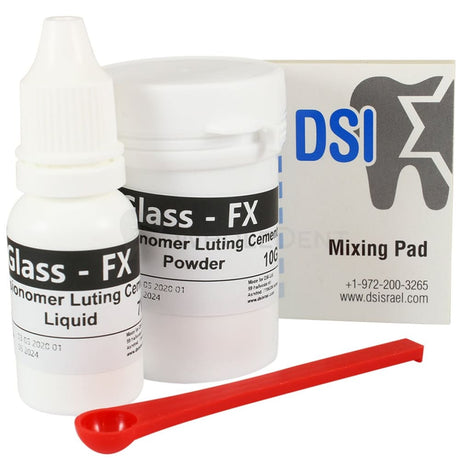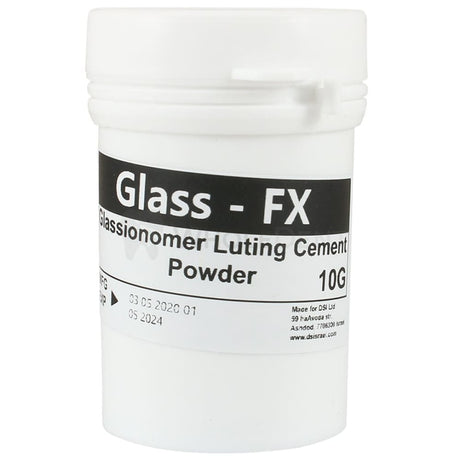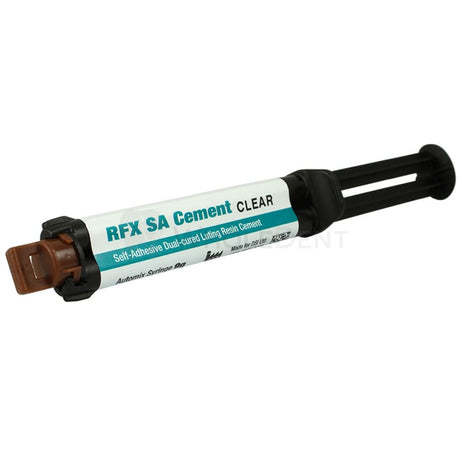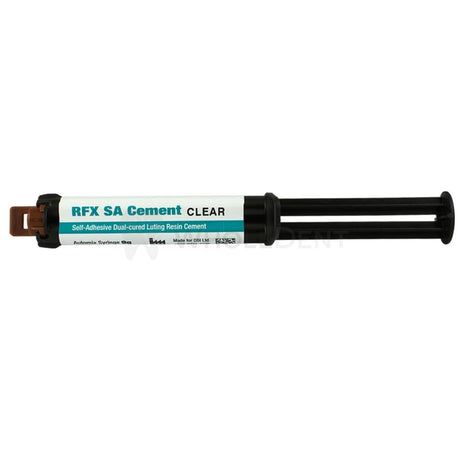Cemento permanente de ionómero DSI Glass FX
$25.00 as low as $22.50Precio unitario /AgotadoGDT Supplies Resina Cemento de fijación permanente
$85.00 as low as $76.50Precio unitario /AgotadoCemento de fijación de ionómero DSI Glass FX Plus
$33.90 as low as $30.51Precio unitario /AgotadoCemento de ionómero de vidrio Spofa Dental Kavitan LC
$44.90 as low as $40.41Precio unitario /AgotadoCemento permanente de ionómero transparente DSI Glass FX
$35.90 as low as $32.31Precio unitario /AgotadoDSI ApexPaste Pasta sin yodoformo de hidróxido de calcio
Desde $17.90Precio unitario /AgotadoPasta de hidróxido de calcio DSI
$17.90 as low as $16.11Precio unitario /AgotadoDSI ApexPaste Hidróxido de calcio con pasta de yodoformo Jeringa de 2 g
$19.90 as low as $17.91Precio unitario /AgotadoDSI ApexPaste Hidróxido de calcio Pasta no yodoformo Jeringa de 2 g
$19.90 as low as $17.91Precio unitario /AgotadoDSI ApexPaste Bio Pulpa Pasta Jeringa 2g
$29.90 as low as $26.91Precio unitario /AgotadoDSI Glass FX Acondicionador Dentina 10ml
$15.90 as low as $14.31Precio unitario /AgotadoCemento bioionómero DSI Glass FX
$79.90 as low as $71.91Precio unitario /AgotadoPrevest polvo de óxido de zinc
$19.90 as low as $17.91Precio unitario /AgotadoCápsulas DSI Glass FX Micro Caps
$65.00 as low as $58.50Precio unitario /AgotadoCemento temporal transparente sin eugenol DSI UniTemp
$45.00 as low as $40.50Precio unitario /AgotadoCápsulas de ionómero de vidrio GC Fuji Triage
$219.90 as low as $197.91Precio unitario /AgotadoCemento de eugenol temporal DSI T-Bond
$31.00 as low as $27.90Precio unitario /AgotadoCemento de fijación de ionómero de vidrio GC FujiCem Evolve
$229.90 as low as $206.91Precio unitario /AgotadoJuego de cemento de fijación de ionómero de vidrio GC Fuji Plus
$199.90 as low as $179.91Precio unitario /AgotadoCápsulas de cemento de fijación de ionómero de vidrio GC Fuji Plus
$375.00 as low as $337.50Precio unitario /AgotadoJuego de cemento de fijación de ionómero de vidrio GC Fuji I
$139.90 as low as $125.91Precio unitario /AgotadoCemento de fijación temporal GC Freegenol
$75.00 as low as $67.50Precio unitario /AgotadoAgente limpiador de cavidades GC Dentin Conditioner 25 g
$115.00 as low as $103.50Precio unitario /AgotadoCompuesto GC G-ænial Universal Flo X
$125.00 as low as $112.50Precio unitario /AgotadoSpident EsCem Self-Adhesive Resin Cement
$129.90 as low as $116.91Precio unitario /Agotado
FAQs
Dental cements and liners are usually designed as chemical or light-cured formulations. There are five general types that dentists can choose from depending on the specific procedure they are doing and the location of the damaged tooth. These five types are:
- Resin cement
- Glass ionomer cement
- Resin-modified glass-ionomer cement
- Zinc phosphate cement
- Zinc polycarboxylate cement
Each of the materials used in cements and liners works in a distinct way that allows the dentist to achieve desired and lasting results. They differ in terms of bonding strength, so the dentist has to know how much force is going to be exerted before choosing their preferred material.
n restorative dentistry, liners and cements serve distinct yet crucial roles. Liners are applied as thin layers within a tooth cavity primarily to shield the dental pulp from thermal and chemical stresses from other restorative materials. They often contain therapeutic substances that support pulp health and cover exposed dentin, acting as a barrier against potential irritants.
Dental cements, on the other hand, are versatile materials used both for filling cavities or gaps and for securing restorations like crowns, bridges, and inlays to tooth structures, either permanently or temporarily. The choice among different types of cements—such as glass ionomer, resin, and zinc oxide-eugenol—depends on specific clinical requirements including biocompatibility, mechanical strength, and aesthetic needs. This differentiation ensures each material is used optimally according to its properties and the dental needs it serves.
In many cases, you will come across dental cements and liners divided into two categories, adhesive and non-adhesive. As the name suggests, adhesive cements form a bond between the tooth’s hard tissue and the restoration material. This type of retention is micromechanical and chemical.
Non-adhesive cements, on the other hand, use mechanical retention to hold everything together. These types of cements are usually based on the use of a reactive filler and water. Although technological advancements now mean that cements and liners may not be as important as they once were, they are still used depending on the procedure being conducted.
There is no one-size-fits-all type of cement or liner that can be used by a dentist. Choosing the best option for a particular procedure requires looking at the type of treatments to be done and the current condition of the periodontal tissue.
A good dentist will also consider the type of substrate being bound, the procedure they will use, the restoration material, and the required duration. As such, any of the five common types of dental cements and liners can be used to produce great results on various restorative procedures.


















































